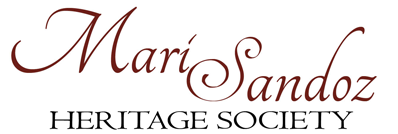Mari Sandoz, Obscenity, and the Slogum House Bans
When Dan Butler, the former mayor of Omaha from 1936 until 1945, died in 1953 his obituary ran in The New York Herald Tribune, which distilled his political accomplishments own to bans on Jack Kirkland’s dramatization of Tobacco Road by Erskine Caldwell and Mari Sandoz’s Slogum House.[1] Butler was not alone in banning Slogum House. McCook, Nebraska’s city library enacted the first ban in January 1938. These home state bans drove national press coverage, foreshadowed further bans of her work in the United States and abroad, and amplified the mixed reaction the novel received.
At this tense moment when book bans are subjects of the evening news and fraught political debate, it is worth investigating the efforts to remove Sandoz from bookshelves and how she responded to these actions and her critics. Slogum House was driven by Sandoz’s critical interrogation of fascism and possibility of its manifestation in the American West.[2] Given Sandoz’s aim, the book’s reception, and contemporary relevance, a fuller illumination of the bans is timely. Beyond Slogum House, the proposed research explores Sandoz’s contested relationship with the political landscape of interwar Nebraska. Moreover, it offers further insights into public and private responses Sandoz received of her fictional work.
At the first McCook library board meeting of 1938, Slogum House was banned after members circulated it among themselves.[3] Omaha soon followed when Mayor Butler deemed Slogum House “filthy” and ordered it removed from Omaha libraries.[4] When news of the ban came into New York Sandoz informed a New York Herald Tribune reporter that, “it’s no particular honor to be banned in Omaha, and no reflection either.”[5] Additionally, when she arrived in Washington D.C. to conduct archival work for what later became Cheyenne Autumn, Sandoz told the Washington Post. “I doubt if [Mayor Butler] ever read the book.”[6] The publication of Slogum House also brought threats of blackmail and the dissemination of “concocted tales,” which Sandoz reported to the Lincoln Police.[7] Nor were bans limited to the United States. The Irish government banned Slogum House in 1939 and in 1944 the United States military banned the distribution of Slogum House at its installations.[8]
These bans, while known to Sandoz scholarship, have not received in-depth analysis. Helen Stauffer, Glenda Riley, and Scott Greenwell situated these episodes within the varied critical response Slogum House received.[9] Bans on Sandoz in her home state garnered the substantial contemporary press, but it was the personal connection, rather than book banning itself that sparked public interest. The 1930s and 1940s were awash with national debates about obscenity in film and literature and international images of book burning and censorship in Germany and Italy. Scholars have pointed to Sandoz’s allegorical attacks of fascism in Slogum House, but not looked at how the bans reproduced authoritarian logic Sandoz wrote against.[10] In short, how did position Sandoz herself and her response to book banning within these historical currents?
[1] “Dan B. Butler, Ex-Mayor of Omaha; Banned Play,” New York Herald Tribune, March 15, 1953.
[2] Scott L. Greenwell, “Fascists in Fiction: Two Early Novels of Mari Sandoz,” Western American Literature, Vol. 12, No. 2 (Summer 1977), 133-143.
[3] “‘Slogum House’ Barred From McCook Library, The McCook Daily Gazette, January 14, 1938.
[4] “Omaha Bars Slogum House,” Nebraska Daily News-Press, January 18, 1938.
[5] “Mari Sandoz Indifferent To Omaha Ban on Book,” New York Herald Tribune, January 21, 1938.
[6] “Omaha Ban on Her Latest Book Amazes Authoress Mari Sandoz,” The Washington Post, January 28, 1938.
[7] Mari Sandoz to Walter Anderson, December 10, 1937 in The Letters of Mari Sandoz. Edited by Helen Winter Stauffer (Lincoln: University of Nebraska Press, 1992), 133-134.
[8] “Banned Publications,” The Irish Times, November 11, 1939; “Many Popular Books Banned at Army Camps,” Chicago Daily Tribune, June 19, 1944. The particularities of this ban are unclear as of yet, as Slogum House was also published in an Armed Services Edition in 1944.
[9] Helen Winter Stauffer, Mari Sandoz: Story Catcher of the Plains (Lincoln: University of Nebraska Press, 1982), 120-121; Glenda Riley, “Mari Sandoz’s Slogum House: Greed as Woman,” Great Plains Quarterly, Vol. 16, No. 1 (Winter 1996), 31-32; Greenwell, “Fascists in Fiction,” 138.
[10] Greenwell, “Fascists in Fiction,” 133-143.
-
CLICK ON LINK TO DOWNLOAD AND READ THE PAPER

Dr. Nathan Tye, Associate Professor of Nebraska and American West History at the University of Nebraska-Kearney (UNK)
Born and raised in Nebraska, Tye received his PhD from the University of Illinois Urbana-Champaign in 2019. A labor historian by training, Tye studies transient agricultural laborers, better known as hobos, in the Progressive Era, and has published studies of transient labor in Nebraska History and the Annals of Iowa. He is also an avid literary historian, with work appearing in The Willa Cather Review and The Walt Whitman Quarterly Review, among other venues. A dedicated local and community historian, Tye is a frequent speaker on Nebraska history, including an appearance on NBC’s Who Do You Think You Are? He serves on the boards of several community museums and cultural organizations including the G.W. Frank Museum of History and Culture and Buffalo County Historical Society in Kearney and the Japanese Hall at the Legacy of the Plains Museum in Gering.
